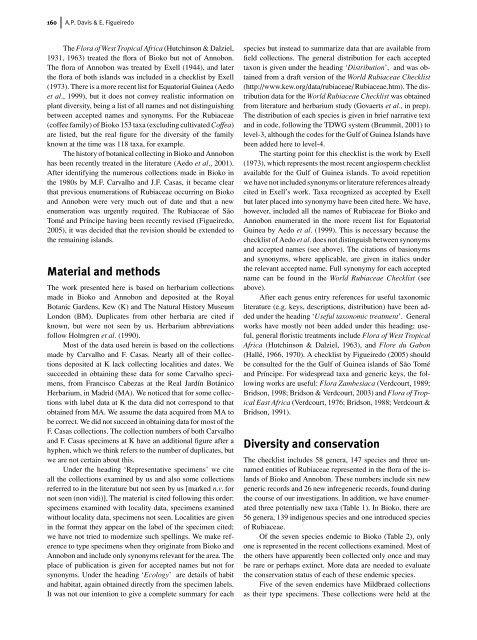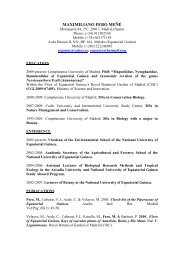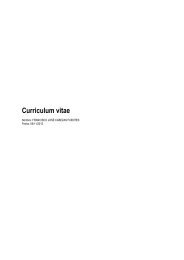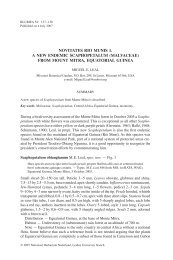A checklist of the Rubiaceae (coffee family) of Bioko and Annobon ...
A checklist of the Rubiaceae (coffee family) of Bioko and Annobon ...
A checklist of the Rubiaceae (coffee family) of Bioko and Annobon ...
Create successful ePaper yourself
Turn your PDF publications into a flip-book with our unique Google optimized e-Paper software.
160 A.P. Davis & E. Figueiredo<br />
The Flora <strong>of</strong> West Tropical Africa (Hutchinson & Dalziel,<br />
1931, 1963) treated <strong>the</strong> flora <strong>of</strong> <strong>Bioko</strong> but not <strong>of</strong> <strong>Annobon</strong>.<br />
The flora <strong>of</strong> <strong>Annobon</strong> was treated by Exell (1944), <strong>and</strong> later<br />
<strong>the</strong> flora <strong>of</strong> both isl<strong>and</strong>s was included in a <strong>checklist</strong> by Exell<br />
(1973). There is a more recent list for Equatorial Guinea (Aedo<br />
et al., 1999), but it does not convey realistic information on<br />
plant diversity, being a list <strong>of</strong> all names <strong>and</strong> not distinguishing<br />
between accepted names <strong>and</strong> synonyms. For <strong>the</strong> <strong>Rubiaceae</strong><br />
(c<strong>of</strong>fee <strong>family</strong>) <strong>of</strong> <strong>Bioko</strong> 153 taxa (excluding cultivated C<strong>of</strong>fea)<br />
are listed, but <strong>the</strong> real figure for <strong>the</strong> diversity <strong>of</strong> <strong>the</strong> <strong>family</strong><br />
known at <strong>the</strong> time was 118 taxa, for example.<br />
The history <strong>of</strong> botanical collecting in <strong>Bioko</strong> <strong>and</strong> <strong>Annobon</strong><br />
has been recently treated in <strong>the</strong> literature (Aedo et al., 2001).<br />
After identifying <strong>the</strong> numerous collections made in <strong>Bioko</strong> in<br />
<strong>the</strong> 1980s by M.F. Carvalho <strong>and</strong> J.F. Casas, it became clear<br />
that previous enumerations <strong>of</strong> <strong>Rubiaceae</strong> occurring on <strong>Bioko</strong><br />
<strong>and</strong> <strong>Annobon</strong> were very much out <strong>of</strong> date <strong>and</strong> that a new<br />
enumeration was urgently required. The <strong>Rubiaceae</strong> <strong>of</strong> São<br />
Tomé<strong>and</strong>Príncipe having been recently revised (Figueiredo,<br />
2005), it was decided that <strong>the</strong> revision should be extended to<br />
<strong>the</strong> remaining isl<strong>and</strong>s.<br />
Material <strong>and</strong> methods<br />
The work presented here is based on herbarium collections<br />
made in <strong>Bioko</strong> <strong>and</strong> <strong>Annobon</strong> <strong>and</strong> deposited at <strong>the</strong> Royal<br />
Botanic Gardens, Kew (K) <strong>and</strong> The Natural History Museum<br />
London (BM). Duplicates from o<strong>the</strong>r herbaria are cited if<br />
known, but were not seen by us. Herbarium abbreviations<br />
follow Holmgren et al. (1990).<br />
Most <strong>of</strong> <strong>the</strong> data used herein is based on <strong>the</strong> collections<br />
made by Carvalho <strong>and</strong> F. Casas. Nearly all <strong>of</strong> <strong>the</strong>ir collections<br />
deposited at K lack collecting localities <strong>and</strong> dates. We<br />
succeeded in obtaining <strong>the</strong>se data for some Carvalho specimens,<br />
from Francisco Cabezas at <strong>the</strong> Real Jardín Botánico<br />
Herbarium, in Madrid (MA). We noticed that for some collections<br />
with label data at K <strong>the</strong> data did not correspond to that<br />
obtained from MA. We assume <strong>the</strong> data acquired from MA to<br />
be correct. We did not succeed in obtaining data for most <strong>of</strong> <strong>the</strong><br />
F. Casas collections. The collection numbers <strong>of</strong> both Carvalho<br />
<strong>and</strong> F. Casas specimens at K have an additional figure after a<br />
hyphen, which we think refers to <strong>the</strong> number <strong>of</strong> duplicates, but<br />
we are not certain about this.<br />
Under <strong>the</strong> heading ‘Representative specimens’ we cite<br />
all <strong>the</strong> collections examined by us <strong>and</strong> also some collections<br />
referred to in <strong>the</strong> literature but not seen by us [marked n.v. for<br />
not seen (non vidi)]. The material is cited following this order:<br />
specimens examined with locality data, specimens examined<br />
without locality data, specimens not seen. Localities are given<br />
in <strong>the</strong> format <strong>the</strong>y appear on <strong>the</strong> label <strong>of</strong> <strong>the</strong> specimen cited;<br />
we have not tried to modernize such spellings. We make reference<br />
to type specimens when <strong>the</strong>y originate from <strong>Bioko</strong> <strong>and</strong><br />
<strong>Annobon</strong> <strong>and</strong> include only synonyms relevant for <strong>the</strong> area. The<br />
place <strong>of</strong> publication is given for accepted names but not for<br />
synonyms. Under <strong>the</strong> heading ‘Ecology’ are details <strong>of</strong> habit<br />
<strong>and</strong> habitat, again obtained directly from <strong>the</strong> specimen labels.<br />
It was not our intention to give a complete summary for each<br />
species but instead to summarize data that are available from<br />
field collections. The general distribution for each accepted<br />
taxon is given under <strong>the</strong> heading ‘Distribution’, <strong>and</strong> was obtained<br />
from a draft version <strong>of</strong> <strong>the</strong> World <strong>Rubiaceae</strong> Checklist<br />
(http://www.kew.org/data/rubiaceae/ <strong>Rubiaceae</strong>.htm). The distribution<br />
data for <strong>the</strong> World <strong>Rubiaceae</strong> Checklist was obtained<br />
from literature <strong>and</strong> herbarium study (Govaerts et al., inprep).<br />
The distribution <strong>of</strong> each species is given in brief narrative text<br />
<strong>and</strong> in code, following <strong>the</strong> TDWG system (Brummit, 2001) to<br />
level-3, although <strong>the</strong> codes for <strong>the</strong> Gulf <strong>of</strong> Guinea Isl<strong>and</strong>s have<br />
been added here to level-4.<br />
The starting point for this <strong>checklist</strong> is <strong>the</strong> work by Exell<br />
(1973), which represents <strong>the</strong> most recent angiosperm <strong>checklist</strong><br />
available for <strong>the</strong> Gulf <strong>of</strong> Guinea isl<strong>and</strong>s. To avoid repetition<br />
we have not included synonyms or literature references already<br />
cited in Exell’s work. Taxa recognized as accepted by Exell<br />
but later placed into synonymy have been cited here. We have,<br />
however, included all <strong>the</strong> names <strong>of</strong> <strong>Rubiaceae</strong> for <strong>Bioko</strong> <strong>and</strong><br />
<strong>Annobon</strong> enumerated in <strong>the</strong> more recent list for Equatorial<br />
Guinea by Aedo et al. (1999). This is necessary because <strong>the</strong><br />
<strong>checklist</strong> <strong>of</strong> Aedo et al. does not distinguish between synonyms<br />
<strong>and</strong> accepted names (see above). The citations <strong>of</strong> basionyms<br />
<strong>and</strong> synonyms, where applicable, are given in italics under<br />
<strong>the</strong> relevant accepted name. Full synonymy for each accepted<br />
name can be found in <strong>the</strong> World <strong>Rubiaceae</strong> Checklist (see<br />
above).<br />
After each genus entry references for useful taxonomic<br />
literature (e.g. keys, descriptions, distribution) have been added<br />
under <strong>the</strong> heading ‘Useful taxonomic treatment’. General<br />
works have mostly not been added under this heading; useful,<br />
general floristic treatments include Flora <strong>of</strong> West Tropical<br />
Africa (Hutchinson & Dalziel, 1963), <strong>and</strong> Flore du Gabon<br />
(Hallé, 1966, 1970). A <strong>checklist</strong> by Figueiredo (2005) should<br />
be consulted for <strong>the</strong> <strong>the</strong> Gulf <strong>of</strong> Guinea isl<strong>and</strong>s <strong>of</strong> São Tomé<br />
<strong>and</strong> Príncipe. For widespread taxa <strong>and</strong> generic keys, <strong>the</strong> following<br />
works are useful: Flora Zambesiaca (Verdcourt, 1989;<br />
Bridson, 1998; Bridson & Verdcourt, 2003) <strong>and</strong> Flora <strong>of</strong> Tropical<br />
East Africa (Verdcourt, 1976; Bridson, 1988; Verdcourt &<br />
Bridson, 1991).<br />
Diversity <strong>and</strong> conservation<br />
The <strong>checklist</strong> includes 58 genera, 147 species <strong>and</strong> three unnamed<br />
entities <strong>of</strong> <strong>Rubiaceae</strong> represented in <strong>the</strong> flora <strong>of</strong> <strong>the</strong> isl<strong>and</strong>s<br />
<strong>of</strong> <strong>Bioko</strong> <strong>and</strong> <strong>Annobon</strong>. These numbers include six new<br />
generic records <strong>and</strong> 26 new infregeneric records, found during<br />
<strong>the</strong> course <strong>of</strong> our investigations. In addition, we have enumerated<br />
three potentially new taxa (Table 1). In <strong>Bioko</strong>, <strong>the</strong>re are<br />
56 genera, 139 indigenous species <strong>and</strong> one introduced species<br />
<strong>of</strong> <strong>Rubiaceae</strong>.<br />
Of <strong>the</strong> seven species endemic to <strong>Bioko</strong> (Table 2), only<br />
one is represented in <strong>the</strong> recent collections examined. Most <strong>of</strong><br />
<strong>the</strong> o<strong>the</strong>rs have apparently been collected only once <strong>and</strong> may<br />
be rare or perhaps extinct. More data are needed to evaluate<br />
<strong>the</strong> conservation status <strong>of</strong> each <strong>of</strong> <strong>the</strong>se endemic species.<br />
Five <strong>of</strong> <strong>the</strong> seven endemics have Mildbraed collections<br />
as <strong>the</strong>ir type specimens. These collections were held at <strong>the</strong>






